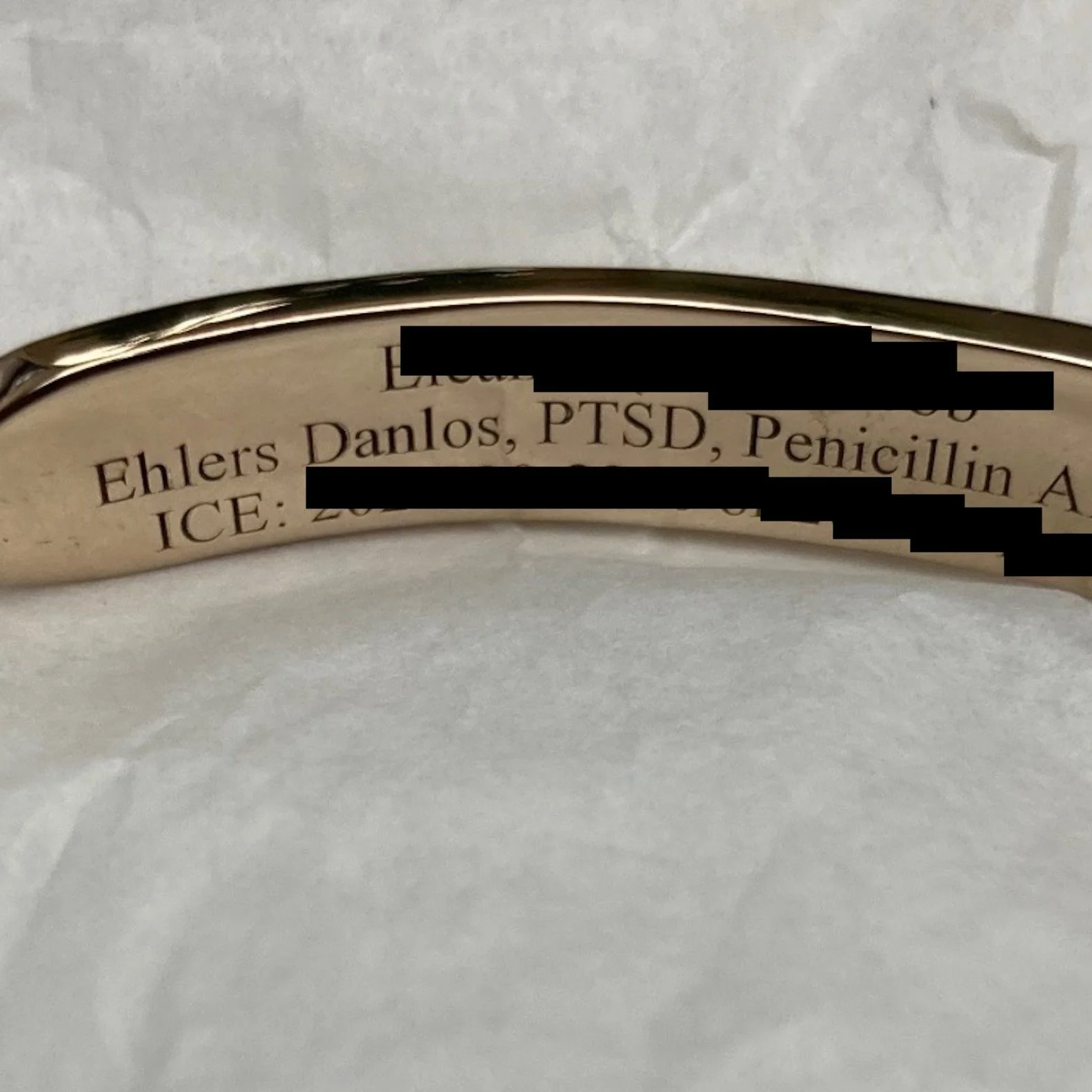Ehlers Danlos Syndrome Medical Alert Bracelets
Ehlers-Danlos Syndrome (EDS) is a genetic disorder that affects the body's connective tissue, causing it to become weak and fragile. It is a group of rare disorders that can affect individuals in different ways, ranging from mild to severe. Although there are different types of EDS, they all share the common feature of hypermobility, which is the ability of the joints to move beyond the normal range of motion. In this article, we will discuss the types of EDS, the importance of wearing a medical ID bracelet if you have EDS, and what to include on your medical ID bracelet.
THE IMPORTANCE OF WEARING A MEDICAL ID BRACELET IF YOU HAVE EDS
EDS is a rare disorder, and many medical professionals may not be familiar with it. This lack of awareness can lead to delayed or incorrect diagnosis, and treatment. Wearing a medical ID bracelet can help medical professionals quickly identify that you have EDS, which can help prevent medical errors and ensure that you receive appropriate treatment.
In addition to providing medical professionals with important information, wearing a medical ID bracelet can also alert others to your condition. For example, if you are involved in an accident or medical emergency and are unable to communicate, your medical ID bracelet can provide first responders with important information about your condition and any medications you are taking.
WHAT TO INCLUDE ON YOUR MEDICAL ID BRACELET
When creating a medical ID bracelet, it is important to include information that is relevant to your condition. If you have EDS, the following information should be included on your medical ID bracelet:
Your name: This is important so that medical professionals can address you properly.
EDS: This should be clearly stated on the bracelet to alert medical professionals to your condition.
Emergency contact: This should include the name and phone number of a family member or friend who can be contacted in case of an emergency.
Medications: List any medications
TYPES OF EDS
There are 13 types of EDS, and each type is caused by a specific genetic mutation that affects the body's production of collagen. Collagen is a protein that provides strength and elasticity to the connective tissue. The different types of EDS are classified based on their symptoms and the genetic mutation responsible for the condition. The following are some of the most common types of EDS:
Classical EDS: This is the most common type of EDS and is caused by mutations in the COL5A1 or COL5A2 genes. Symptoms include skin that is easily bruised, hypermobility, and joint pain.
Hypermobility EDS: This type of EDS is caused by mutations in the COL3A1 gene and is characterized by joint hypermobility, chronic pain, and fatigue.
Vascular EDS: This type of EDS is caused by mutations in the COL3A1 gene and is the most severe form of EDS. Symptoms include thin, translucent skin, easy bruising, and fragile blood vessels, which can lead to internal bleeding and organ damage.
Kyphoscoliotic EDS: This type of EDS is caused by mutations in the PLOD1 or FKBP14 genes and is characterized by severe curvature of the spine (kyphoscoliosis), muscle weakness, and joint hypermobility.
Arthrochalasia EDS: This type of EDS is caused by mutations in the COL1A1 or COL1A2 genes and is characterized by severe joint hypermobility and congenital hip dislocation.
Dermatosparaxis EDS: This type of EDS is caused by mutations in the ADAMTS2 gene and is characterized by extremely fragile skin that tears easily.
EHLERS DANLOS ONLINE RESOURCES
Ehlers-Danlos Society: The Ehlers-Danlos Society is a global organization that aims to raise awareness, provide resources, and support research on EDS and related disorders. They offer information about different types of EDS, management strategies, and opportunities to connect with others in the EDS community.
EDS Support UK: EDS Support UK is a UK-based organization that provides information, support, and advocacy for individuals and families affected by EDS. They offer resources, local support groups, and educational materials.
The Hypermobility Syndromes Association (HMSA): HMSA is a UK-based organization that supports individuals with hypermobility-related conditions, including various types of EDS. They provide resources, educational materials, and a community forum for sharing experiences.
EDS Awareness: EDS Awareness is a platform that offers educational resources, webinars, and articles about EDS and its various manifestations. They also help individuals connect with local support groups.
Chronic Pain Partners: This organization focuses on providing support and resources for individuals with chronic pain conditions, including EDS. They offer information, articles, and support groups to help individuals manage their conditions.
Ben's Friends: Ehlers-Danlos Syndrome Support Community, Ben's Friends is an online platform that hosts support communities for various health conditions, including EDS. The EDS community allows individuals to share experiences, ask questions, and provide support to one another.
Rare Disease United Foundation: The Rare Disease United Foundation advocates for individuals with rare diseases, including rare forms of EDS. They work to raise awareness, provide resources, and support research for rare diseases.
Genetic and Rare Diseases Information Center (GARD): GARD, a program of the National Institutes of Health (NIH), offers information about rare genetic conditions, including EDS. Their website provides resources, contact information for experts, and information about ongoing research.

